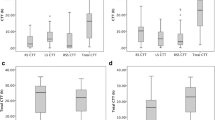Abstract
The colonic response to food (CRF) is an integrated function of the colon that has been poorly studied in clinical practice. This study describes a new method to measure it, based on the progress of radio-opaque markers, and shows the results in healthy subjects and in patients with irritable bowel syndrome (IBS). Thirty healthy subjects and 43 patients suffering from IBS were studied. Two studies of colonic transit time (CTT), at rest and after eating a standard test meal, were performed. CRF was quantified by calculating the variation in number of markers in each zone of interest of the large bowel using X-ray films of the abdomen taken before and after eating. The results were as follows: (1) CRF is characterised by caudal propulsion of the colonic contents in the two groups. In controls, there is emptying of the cecum-ascending colon region and filling of the distal large bowel. In IBS patients, only emptying of the left transverse colon and the splenic flexure is found. (2) IBS patients have a delayed CTT because of slowing in the right and left colon, and this is both before and after a meal. The determination of the movements of markers after eating is a simple method that is useful in clinical practice to evaluate CRF.
Similar content being viewed by others
Author information
Authors and Affiliations
Additional information
Accepted: 20 May 1998
Rights and permissions
About this article
Cite this article
Bouchoucha, M., Odinot, JM., Devroede, G. et al. Simple clinical assessment of colonic response to food. Int J Colorect Dis 13, 217–222 (1998). https://doi.org/10.1007/s003840050164
Issue Date:
DOI: https://doi.org/10.1007/s003840050164




